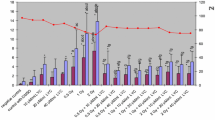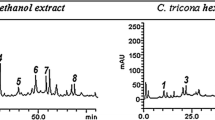Abstract
Beta-sitosterol (BS) is a compound that has shown various activities potentially useful for human health. In the present study, we determined its antigenotoxic capacity and lymphocyte induction potential in mouse as well as its capacity to trap free radicals in vitro. BS, in doses from 200 to 1,000 mg/kg, was able to significantly reduce the frequency of sister chromatid exchanges induced by 10 mg/kg of doxorubicin (DX) in bone marrow cells. The same range of BS doses also gave rise to a strong reduction in the rate of micronucleated, polychromatic erythrocytes induced by DX. In addition, we determined an increase in the production of lymphocytes in mice administered with BS. By means of the DPPH assay, the compound was shown to trap free radicals in a concentration dependent manner as high as 78.12% using 250 μg/ml. Our research established three relevant biological activities of BS which show its potential as a chemopreventive agent.


Similar content being viewed by others
References
Aguilar JL, Rojas P, Marcelo A, Plaza A, Bauer R, Reininger E, Klaas CA, Merfort I (2002) Anti-inflammatory activity of two different extracts of Uncaria tomentosa (Rubiaceae). J Ethnopharmacol 81:271–276
Antolovich M, Prenzler PD, Patsalides E, McDonald S, Robards K (2002) Methods for testing antioxidant activity. Analyst 127:183–198
Awad AB, Fink CS (2000) Phytosterols as anticancer dietary components: evidence and mechanism of action. J Nutr 130:2127–2130
Awad AB, von Holtz RL, Cone JP, Fink CS, Chen YC (1998) beta-Sitosterol inhibits the growth of HT-29 human colon cancer cells by activating the sphingomyelin cycle. Anticancer Res 18:471–479
Berges RR, Windeler J, Trampisch HJ, Senge T (1995) Randomised, placebo-controlled, double-blind clinical trial of beta-sitosterol in patients with benign prostatic hyperplasia. Beta-sitosterol Study Group. Lancet 345:1529–1532
Berges RR, Kassen A, Senge T (2000) Treatment of symptomatic benign prostatic hyperplasia with beta-sitosterol: an 18-month follow-up. BJU Int 85:842–846
Bouic PJ (2001) The role of phytosterols and phytosterolins in immune modulation: a review of the past 10 years. Curr Opin Clin Nutr Metab Care 4:471–475
Bouic PJ, Etsebeth S, Leibenberg RW, Albrecht CF, Pegel K, Van Jaarsveld PP (1996) beta-Sitosterol and beta-sitosterol glucoside stimulate human peripheral blood lymphocyte proliferation: implications for their use as an immunomodulatory vitamin combination. Int J Immunopharmacol 18:693–700
Bouic PJ, Clark A, Lamprecht J, Freestone M, Pool EJ, Liebenberg RW, Kotze D, van Jaarsveld PP (1999) The effects of B-sitosterol (BSS) and B-sitosterol glucoside (BSSG) mixture on selected immune parameters of marathon runners: inhibition of post marathon immune suppression and inflammation. Int J Sports Med 20:258–262
Breytenbach U, Clark A, Lamprecht J, Bouic P (2001) Flow cytometric analysis of the Th1–Th2 balance in healthy individuals and patients infected with the human immunodeficiency virus (HIV) receiving a plant sterol/sterolin mixture. Cell Biol Int 25:43–49
Chen HC (2001) Molecular mechanisms of sterol absorption. J Nutr 131:2603–2605
Delaporte RH, Sarragiotto MH, Takemura OS, Sanchez GM, Filho BP, Nakamura CV (2004) Evaluation of antioedematogenic free radical scavenging and antimicrobial activities of aerial parts of Tillandisiastreptocarpa Baker-Bromeliaceae. J Ethnopharmacol 95:229–233
Gorinstein S, Martin-Belloso O, Katrich E, Lojek A, Cìz M, Gligelmo-Miguel N, Harnenkit R, Park YS, Jung ST, Trakhtenberg S (2003) Comparison of the contents of the main biochemical compounds and the antioxidant activity of some Spanish olive oils as determined by four different radical scavenging test. J Nutr Biochem 14:154–159
Gupta MB, Nath R, Srivastava N, Shanker K, Kishor K, Bhargava KP (1980) Anti-inflammatory and antipyretic activities of beta-sitosterol. Planta Med 39:157–163
Han C, Ding H, Casto B, Stoner GD, D’Ambrosio SM (2005) Inhibition of the growth of premalignant and malignant human oral cell lines by extracts and components of black raspberries. Nutr Cancer 51:207–217
Haydn Pritchard P, Li M, Zamfir C, Lukic T, Novak E, Moghadasian MH (2003) Comparison of cholesterol-lowering efficacy and anti-atherogenic properties of hydrogenated versus non-hydrogenated (Phytrol™) tall oil-derived phytosterols in apo E-deficient mice. Cardiovasc Drugs Ther 17:443–449
Hendriks HF, Brink EJ, Meijer GW, Princen HM, Ntanios FY (2003) Safety of long-term consumption of plant sterol esters-enriched spread. Eur J Clin Nutr 57:681–692
Hernandez-Ceruelos A, Madrigal-Bujaidar E, de la Cruz C (2004) Inhibitory effect of chamomile essential oil on the sister chromatid exchanges induced by daunorubicin and methyl methanesulfonate in mouse bone marrow. Toxicol Lett 135:103–110
Jayaprakasha GK, Mandadi KK, Poulose SM, Jadegoud Y, Nagana Gowda GA, Patil BS (2007) Inhibition of colon cancer cell growth and antioxidant activity of bioactive compounds from Poncirus trifoliata (L.) Raf. Bioorg Med Chem 15:4923–4932
Ju YH, Claussen LM, Allred KF, Almada AL, Helferich WG (2004) Beta-sistosterol, beta-sistoterol glucoside, and a mixture of beta-sitosterol and beta-sitosterol glucoside modulate the growth of estrogen-responsive breast cancer cells in vitro and in ovariectomized athymic mice. J Nutr 134:1139–1144
Kassen A, Berges R, Senge T (2000) Effect of beta-sitosterol on transforming growth factor-beta-1 expression and translocation protein kinase C alpha in human prostate stromal cells in vitro. Eur Urol 37:735–741
Keplinger K, Laus G, Wurm M, Dierich MP, Teppner H (1999) Uncaria tomentosa (Willd.) DC.––ethnomedicinal use and new pharmacological, toxicological and botanical results. J Ethnopharmacol 64:23–34
Khan MA, Mustafa J, Musarrat J (2003) Mechanism of DNA strand breakage induced by photosensitized tetracycline–Cu(II) complex. Mutat Res 525:109–119
Klippel KF, Hiltl DM, Schipp B (1997) A multicentric, placebo-controlled, double-blind clinical trial of beta-sitosterol (phytosterol) for the treatment of benign prostatic hyperplasia. German BPH-Phyto Study group. Br J Urol 80:427–432
Kocak N, Ustun H, Gulkac MD, Kanli AO, Borazan A, Yilmaz A (2004) Effects of 10alpha,25-dihydroxyvitamin D3 on doxorubicin-induced chromosomal aberrations in rat bone marrow cells. Acta Oncol 43:204–208
Lim JC, Park JH, Budesinsky M, Kasal A, Han YH, Koo BS, Lee SI, Lee DU (2005) Antimutagenic constituents from the thorns of Gleditsia sinensis. Chem Pharm Bull 53:561–564
Ling WH, Jones PJ (1995) Dietary phytosterols: a review of metabolism, benefits and side effects. Life Sci 57:195–206
Madrigal-Santillán E, Madrigal-Bujaidar E, Marquez-Marquez R, Reyes A (2006) Antigenotoxic effect of Saccharomyces cereviciae on the damage produced in mice fed with aflatoxin B(1) contaminated corn. Food Chem Toxicol 44:2058–2063
Melichar B, Tousková M, Dvorák J, Jandik P, Kopecký O (2001) The peripheral blood leukocyte phenotype in patients with breast cancer: effect of doxorubicin/paclitaxel combination chemotherapy. Immunopharmacol Immunotoxicol 23:163–173
Mizutani H, Oikawa S, Hiraku Y, Murata M, Kojima M, Kawanishi M (2003) Distinct mechanisms of site-specific oxidative DNA damage by doxorubicin in the presence of copper (II) and NADPH-cytochrome P450 reductase. Cancer Sci 94:686–691
Ovesna Z, Vachalkova A, Horvathova K (2004) Taraxasterol and beta-sitosterol: new naturally compounds with chemoprotective/chemopreventive effects. Neoplasma 51:407–414
Paniagua-Perez R, Madrigal-Bujaidar E, Reyes CS, Perez GJ, Velasco MO, Molina D (2002) Sister chromatid exchanges produced by imipramine and desipramine in mouse bone marrow cells treated in vivo. Toxicol Lett 132:123–129
Paniagua-Perez R, Madrigal-Bujaidar E, Reyes-Cadena S, Molina-Jasso D, Gallaga JP, Silva-Miranda A, Velazco O, Hernández N, Chamorro G (2005) Genotoxic and cytotoxic studies of Beta-sitosterol and pteropodine in mouse. J Biomed Biotechnol 2005:242–247
Park KY, Jung KD, Rhee SH, Choi YH (2003) Antimutagenic effects of doenjang (Koren fermented soypaste) and its active compounds. Mutat Res 523–524:43–53
Pegel KI (1997) The importance of sitosterol and sitosterolin in human and animal nutrition. S Afr J Sci 93:263–268
Raicht RF, Cohen BI, Fazzini EP, Sarwal AN, Takahashi M (1980) Protective effect of plant sterols against chemically induced colon tumors in rats. Cancer Res 40:403–405
Rizzi R, Re F, Bianchi A, De Feo V, de Simone F, Bianchi L, Stivala LA (1993) Mutagenic and antimutagenic activities of Uncaria tomentosa and its extracts. J Ethnopharmacol 38:63–77
Romero-Jimenez M, Campos-Sanchez J, Analla M, Muñoz-Serrano A, Alonso-Moraga A (2005) Genotoxicity and anti-genotoxicity of some traditional medicinal herbs. Mutat Res 585:147–155
Russo A, Aquaviva R, Campisi A, Sorrenti V, Di Giacomo C, Virgata G, Barcellona ML, Vanilla A (2000) Bioflavonoids as antiradicals, antioxidants and DNA cleavage protectors. Cell Biol Toxicol 16:91–98
Sarkar A, Saha BK, Basak R, Mukhopadhyay I, Karmakar R, Chatterjee M (2000) Anticlastogenic potential of 1alpha,25-dihydroxyvitamin D3 in murine lymphoma. Cancer Lett 150:1–13
Snyder RD, Gillies PJ (2002) Evaluation of the clastogenic, DNA intercalative, and topoisomerase II-interactive properties of bioflavonoids in Chinese hamster V79 cells. Environ Mol Mutagen 40:266–276
Takemura G, Fujiwara H (2007) Doxorubicin-induced cardiomyophaty from the cardiotoxic mechanisms to management. Prog Cardiovasc Dis 49:330–352
Takeoka GR, Dao LT (2003) Antioxidant constituents of almond [Prunus dulcis (Mill.) D. A. Webb] hulls. J Agric Food Chem 51:496–501
Tapiero H, Townsend DM, Tew KD (2003) Phytosterols in the prevention of human pathologies. Biomed Pharmacother 57:321–325
Villaseñor IM, Lemon P, Palileo A, Bremner JB (1996) Antigenotoxic spinasterol from Cucurbita maxima flowers. Mutat Res 360:89–93
Villaseñor IM, Angelada J, Canlas AP, Echegoyen D (2002) Bioactivity studies on beta-sitosterol and its glucoside. Phytother Res 16:417–421
Vivancos M, Moreno JJ (2005) beta-Sitosterol modulates antioxidant enzyme response in RAW 264.7 macrophages. Free Radic Biol Med 39:91–97
von Holtz RL, Fink CS, Awad AB (1998) beta-Sitosterol activates the sphingomyelin cycle and induces apoptosis in LNCaP human prostate cancer cells. Nutr Cancer 32:8–12
Zhang XY, Li WG, Wu YJ, Gao MT (2005a) Amelioration of doxorubicin-induced myocardial oxidative stress and immunosuppression by grape seed proanthocyanidins in tumor-bearing mice. J Pharm Pharmacol 57:1043–1052
Zhang XY, Li WG, Wu YJ, Zehng TZ, Li W, Qu SY, Liu NF (2005b) Protoanthocyanidin from grape seeds potentiates anti-tumor activity of doxorubicin via immunomodulatory mechanism. Int Immunopharmacol 5:1247–1257
Author information
Authors and Affiliations
Corresponding author
Rights and permissions
About this article
Cite this article
Paniagua-Pérez, R., Madrigal-Bujaidar, E., Reyes-Cadena, S. et al. Cell protection induced by beta-sitosterol: inhibition of genotoxic damage, stimulation of lymphocyte production, and determination of its antioxidant capacity. Arch Toxicol 82, 615–622 (2008). https://doi.org/10.1007/s00204-007-0277-3
Received:
Accepted:
Published:
Issue Date:
DOI: https://doi.org/10.1007/s00204-007-0277-3




